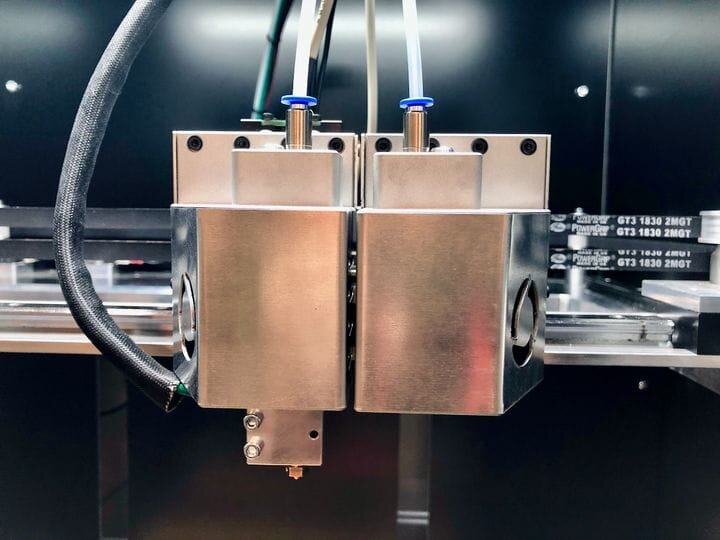![The revolving extruder on the FL300 3D printer (cover on) [Source: Fabbaloo]](https://fabbaloo.com/wp-content/uploads/2020/05/fuselab-extruder-1_img_5eb08ccb0a0c1.jpg)
We had a close look at a very unusual 3D print extruder from startup Fuselab.
The Belgian startup wanted to make changes to the mostly unchanging approach to extruding filament in 3D printers. To date, virtually all methods involve a friction or toothed wheel.
3D Printing Extrusion Systems
Early extrusion systems involved only a single toothed wheel and a smooth friction wheel for pressure. The problem there was that if the teeth broke off a chunk of filament material, there was nothing to grab and extrusion suddenly stopped.
Currently, the most advanced and frequently-seen approach is dual toothed wheels, popularized by BondTech, which mostly solves that issue.
![Typical toothed wheels used in most filament 3D printers [Source: Fabbaloo]](https://fabbaloo.com/wp-content/uploads/2020/05/image-asset_img_5eb08ccb5b9ac.jpg)
In the dual configuration, two wheels are pressed together, and in a filament-sized cavity between them, a couple of teeth bite on the filament from both sides and force it into the hot end. This is a fairly reliable approach, but still jams occasionally when the few teeth that bite the filament chop off material, leaving nothing to grab once again.
Normally this is no longer a major issue, but it will become an issue as systems gain speed and new materials begin use. When pushing filament at high speed there is the possibility of slipping, because the few teeth actively involved can sometimes have enough energy to rip off material from the filament.
Fuselab Extruder
![Unique revolving extruder with cover off on the FL300 3D printer. If you look closely you can see two of the three threaded rods around the filament. [Source: Fabbaloo]](https://fabbaloo.com/wp-content/uploads/2020/05/image-asset_img_5eb08ccb94617.jpg)
Fuselab spent 1.5 years in development to solve this problem. They came up with a highly unusual revolving extruder that is not only fun to watch, but also is extraordinarily accurate and reliable. Here’s how it works:
-
Three threaded rods are placed around the filament at 120 degree positions
-
The rods are positioned so that their teeth will slightly bite into the filament
-
A carriage mechanism holds the rods in place
-
The extrusion motor revolves the carriage
-
Gearing within the revolving carriage causes the rods to each rotate individually
-
The rotating rods’ teeth bite into the filament and force it down
Why does this work? It’s quite simple: each rod provides no less than 5 threads simultaneously biting the filament. And with three rods, you have 15 points of contact on the filament at all times. This is vastly larger than the 4-6 you might see on a BondTech system, and is the source of the system’s reliability.
FuseLab says their system “always delivers the right amount of material.”
Fuselab 3D Printer
![The FL300 3D printer [Source: Fabbaloo]](https://fabbaloo.com/wp-content/uploads/2020/05/image-asset_img_5eb08ccbd8e3e.jpg)
It’s very curious to observe in action, because the extruder appears to spin around the filament path. I’ve never seen anything like it. Fuselab says they have patented the extruder design.
Fuselab has built a 3D printer, the FL300, that uses the revolutionary (in more ways than one) extruder.
Aside from the fancy extruder, the FL300 includes a type of bed mounting system I’ve also never seen. The print bed mounts using corner-positioned spherical magnets. It’s called a “kinematic coupling”.
![The kinematic coupling used on the print bed of the FL300 3D printer [Source: Fabbaloo]](https://fabbaloo.com/wp-content/uploads/2020/05/image-asset_img_5eb08ccc1b2c9.jpg)
I asked what the purpose of this coupling was for, and was told that it is a way to keep the bed from expanding as it heats. This is a way to ensure more accurate part dimensionality. Apparently the concept was derived from measuring machines in other industries.
The FL300 is set to sell to the public in about 5 months, but I suspect the extrusion concept could be of significant interest to certain other large-format 3D printer manufacturers, who have the problem of delivering thermoplastic at high speed to their extruders. It’s possible FuseLab might license some of their tech into other machines.
Via Fuselab

